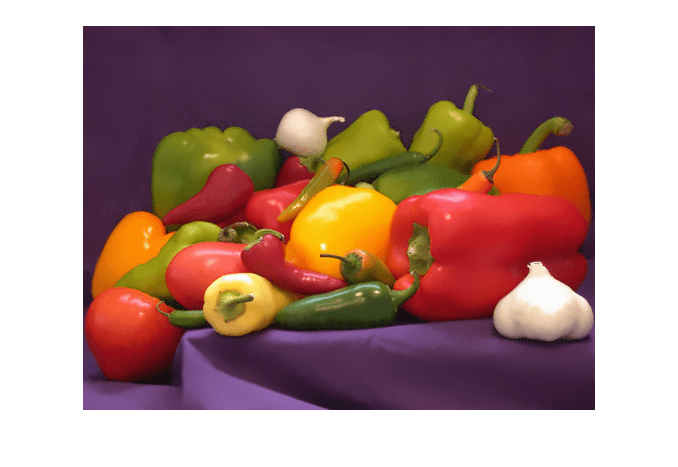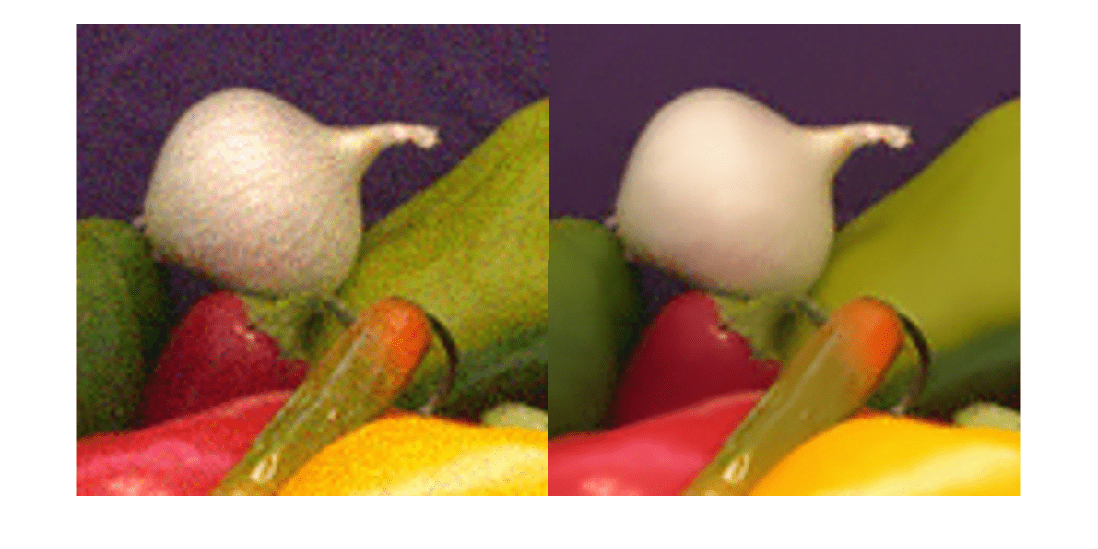imnlmfilt
Non-local means filtering of image
Description
J = imnlmfilt(I,Name,Value)
Examples
Denoise Grayscale Image Using Non-Local Means Filter
Read a grayscale image.
I = imread('cameraman.tif');Add zero-mean white Gaussian noise with 0.0015 variance to the image using the imnoise function.
noisyImage = imnoise(I,'gaussian',0,0.0015);Remove noise from the image through non-local means filtering. The imnlmfilt function estimates the degree of smoothing based on the standard deviation of noise in the image.
[filteredImage,estDoS] = imnlmfilt(noisyImage);
Display the noisy image (left) and the non-local means filtered image (right) as a montage. Display the estimated degree of smoothing, estDoS, in the figure title.
The non-local means filter removes noise from the input image but preserves the sharpness of strong edges, such as the silhouette of the man and buildings. This function also smooths textured regions, such as the grass in the foreground of the image, resulting in less detail when compared to the noisy image.
montage({noisyImage,filteredImage})
title(['Estimated Degree of Smoothing, ', 'estDoS = ',num2str(estDoS)])
Denoise Color Image Using Non-Local Means Filter
Read a color image.
imRGB = imread('peppers.png');Add white Gaussian noise with zero mean and 0.0015 variance to the image using the imnoise function. Display the noisy RGB image.
noisyRGB = imnoise(imRGB,'gaussian',0,0.0015);
imshow(noisyRGB)
Convert the noisy RGB image to the L*a*b color space, so that the non-local means filter smooths perceptually similar colors.
noisyLAB = rgb2lab(noisyRGB);
Extract a homogeneous L*a*b patch from the noisy background to compute the noise standard deviation.
roi = [210,24,52,41]; patch = imcrop(noisyLAB,roi);
In this L*a*b patch, compute the Euclidean distance from the origin, edist. Then, calculate the standard deviation of edist to estimate the noise.
patchSq = patch.^2; edist = sqrt(sum(patchSq,3)); patchSigma = sqrt(var(edist(:)));
Set the 'DegreeOfSmoothing' value to be higher than the standard deviation of the patch. Filter the noisy L*a*b* image using non-local means filtering.
DoS = 1.5*patchSigma;
denoisedLAB = imnlmfilt(noisyLAB,'DegreeOfSmoothing',DoS);Convert the filtered L*a*b image to the RGB color space. Display the filtered RGB image.
denoisedRGB = lab2rgb(denoisedLAB,'Out','uint8'); imshow(denoisedRGB)

Compare a patch from the noisy RGB image (left) and the same patch from the non-local means filtered RGB image (right).
roi2 = [178,68,110,110];
montage({imcrop(noisyRGB,roi2),imcrop(denoisedRGB,roi2)})
Input Arguments
I — Image to filter
2-D grayscale image | 2-D color image
Image to filter, specified as a 2-D grayscale image of size
m-by-n or a 2-D color image of size
m-by-n-by-3. The size of I
must be greater than or equal to 21-by-21.
Data Types: single | double | int8 | int16 | int32 | uint8 | uint16 | uint32
Name-Value Arguments
Specify optional pairs of arguments as
Name1=Value1,...,NameN=ValueN, where Name is
the argument name and Value is the corresponding value.
Name-value arguments must appear after other arguments, but the order of the
pairs does not matter.
Before R2021a, use commas to separate each name and value, and enclose
Name in quotes.
Example: J = imnlmfilt(I,'DegreeOfSmoothing',10);
DegreeOfSmoothing — Degree of smoothing
positive number
Degree of smoothing, specified as the comma-separated pair consisting of
'DegreeOfSmoothing' and a positive number. As this value
increases, the smoothing in the resulting image J increases. If
you do not specify 'DegreeOfSmoothing', then the default value is
the standard deviation of noise estimated from the image. For more information, see
Default Degree of Smoothing.
SearchWindowSize — Search window size
21 (default) | odd-valued positive integer
Search window size, specified as the comma-separated pair consisting of
'SearchWindowSize' and an odd-valued positive integer,
s. The search for similar neighborhoods to a pixel is limited to
the s-by-s region surrounding that pixel.
SearchWindowSize affects the performance linearly in terms of
time. SearchWindowSize cannot be larger than the size of the
input image, I.
ComparisonWindowSize — Comparison window size
5 (default) | odd-valued positive integer
Comparison window size, specified as the comma-separated pair consisting of
'ComparisonWindowSize' and an odd-valued positive integer,
c. The imnlmfilt function computes similarity
weights using the c-by-c neighborhood
surrounding pixels. ComparisonWindowSize must be less than or
equal to SearchWindowSize. For more information, see Estimate Denoised Pixel Value.
Output Arguments
J — Non-local means filtered image
2-D grayscale image | 2-D color image
Non-local means filtered image, returned as a 2-D grayscale image or 2-D color image
of the same size and data type as the input image, I.
estDoS — Estimated degree of smoothing
positive number
Estimated degree of smoothing, returned as a positive number. If you specify
DegreeOfSmoothing, then imnlmfilt returns the
same value in estDoS. Otherwise, imnlmfilt
returns the default degree of smoothing estimated using Default Degree of Smoothing.
Tips
To smooth perceptually close colors in an RGB image, convert the image to the CIE L*a*b* color space using
rgb2labbefore applying the non-local means filter. To view the results, first convert the filtered L*a*b* image to the RGB color space usinglab2rgb.If the data type of
Iisdouble, then computations are performed in data typedouble. Otherwise, computations are performed in data typesingle.
Algorithms
Default Degree of Smoothing
The default value of 'DegreeOfSmoothing' is the standard deviation
of noise estimated from the image. To estimate the standard deviation,
imnlmfilt convolves the image with a 3-by-3 filter proposed by J.
Immerkær [2]. When I is a
color image, the default value of 'DegreeOfSmoothing' is the standard
deviations of noise averaged across the channels.
Estimate Denoised Pixel Value
The non-local means filtering algorithm estimates the denoised value of pixel p using these steps.
For a specific pixel, q, in the search window, calculate the weighted Euclidean distance between pixel values in the c-by-c comparison windows surrounding p and q. For color images, include all channels in the Euclidean distance calculation.
The weight is a decreasing exponential function whose rate of decay is determined by the square of
'DegreeOfSmoothing'. When an image is noisy,'DegreeOfSmoothing'is large and all pixels contribute to the Euclidean distance calculation. When an image has little noise,'DegreeOfSmoothing'is small and only pixels with similar values contribute to the Euclidean distance calculation.The result is a numeric scalar that indicates the similarity between the neighborhood of p and the neighborhood of q.
Note
In the implementation by A. Buades et al. [1], the Euclidean distance between two comparison windows is convolved with a Gaussian kernel of size c-by-c. This convolution gives more weight to the Euclidean distance between pixel values for pixels near the center of the comparison window. The
imnlmfiltfunction omits this step for computational efficiency.Repeat this computation for each of the other pixels in the s-by-s search window, finding the weighted Euclidean distance between pixel p and each of those pixels. The result is an s-by-s similarity matrix that indicates similarity between the neighborhood of p and the other neighborhoods in the search window.
Normalize the similarity matrix.
Using the weights in the normalized similarity matrix, compute the weighted average of pixel values in the s-by-s search window around pixel p. The result is the denoised value of p.
References
[1] Buades, A., B. Coll, and J.-M. Morel. "A Non-Local Algorithm for Image Denoising." 2005 IEEE® Computer Society Conference on Computer Vision and Pattern Recognition. Vol. 2, June 2005, pp. 60–65.
[2] Immerkær, J. "Fast Noise Variance Estimation." Computer Vision and Image Understanding. Vol. 64, Number 2, Sept. 1996, pp. 300–302.
Extended Capabilities
Thread-Based Environment
Run code in the background using MATLAB® backgroundPool or accelerate code with Parallel Computing Toolbox™ ThreadPool.
This function fully supports thread-based environments. For more information, see Run MATLAB Functions in Thread-Based Environment.
Version History
Introduced in R2018bR2022b: Support for thread-based environments
imnlmfilt now supports thread-based
environments.
See Also
MATLAB Command
You clicked a link that corresponds to this MATLAB command:
Run the command by entering it in the MATLAB Command Window. Web browsers do not support MATLAB commands.

Select a Web Site
Choose a web site to get translated content where available and see local events and offers. Based on your location, we recommend that you select: .
You can also select a web site from the following list:
How to Get Best Site Performance
Select the China site (in Chinese or English) for best site performance. Other MathWorks country sites are not optimized for visits from your location.
Americas
- América Latina (Español)
- Canada (English)
- United States (English)
Europe
- Belgium (English)
- Denmark (English)
- Deutschland (Deutsch)
- España (Español)
- Finland (English)
- France (Français)
- Ireland (English)
- Italia (Italiano)
- Luxembourg (English)
- Netherlands (English)
- Norway (English)
- Österreich (Deutsch)
- Portugal (English)
- Sweden (English)
- Switzerland
- United Kingdom (English)